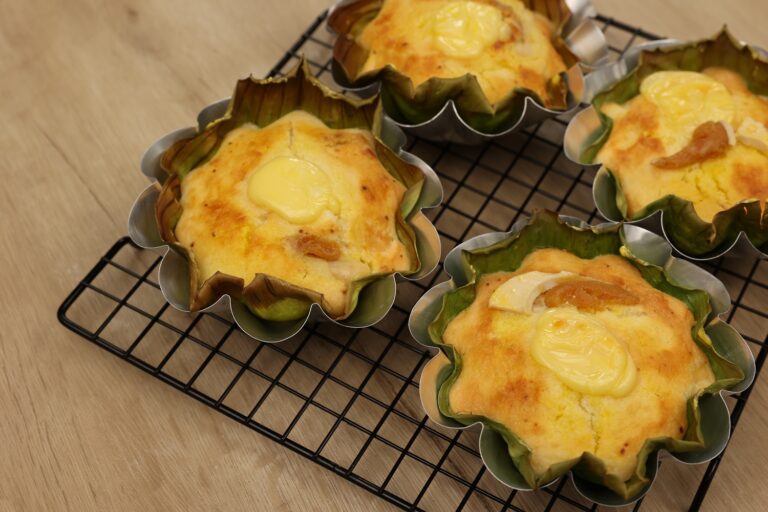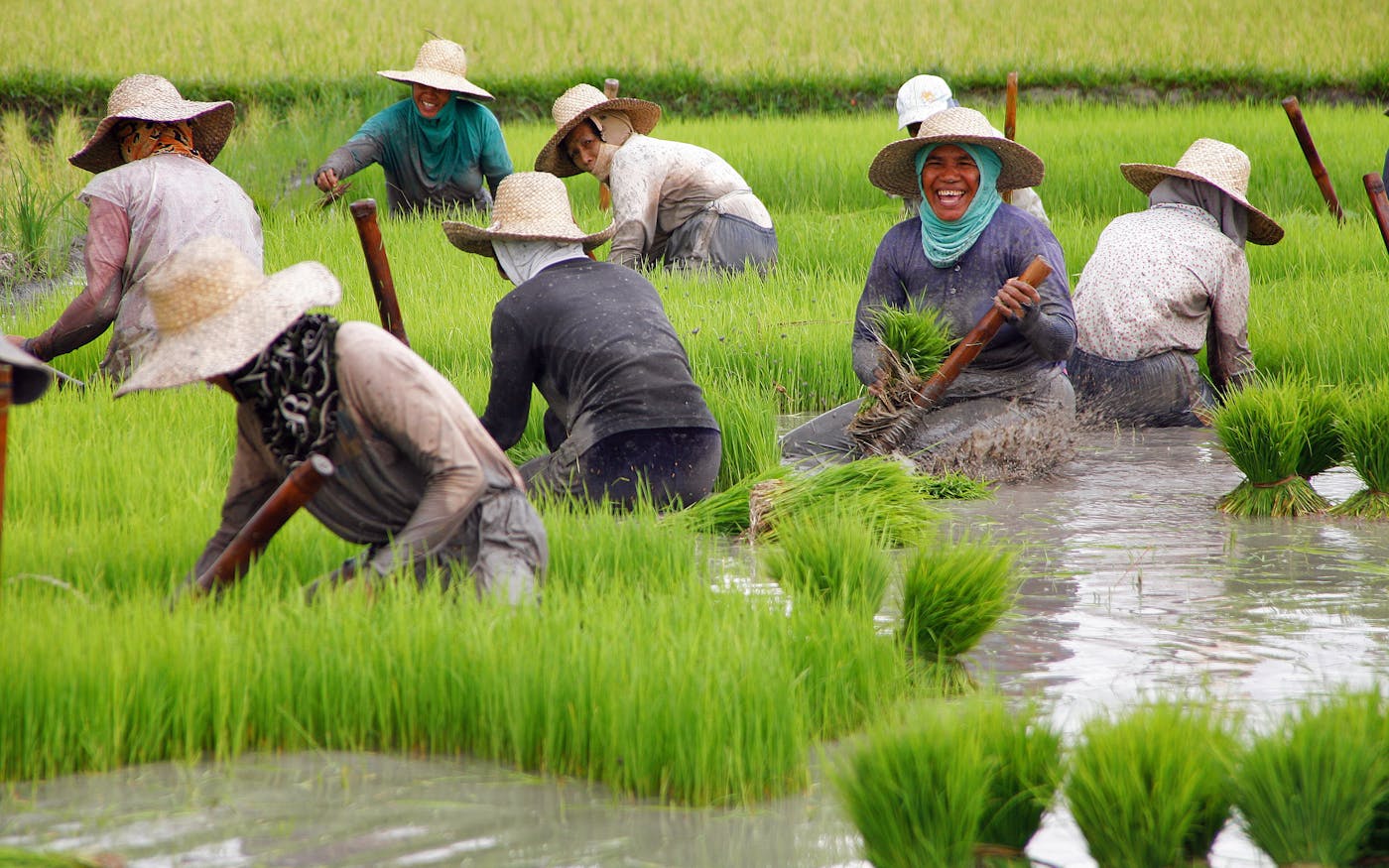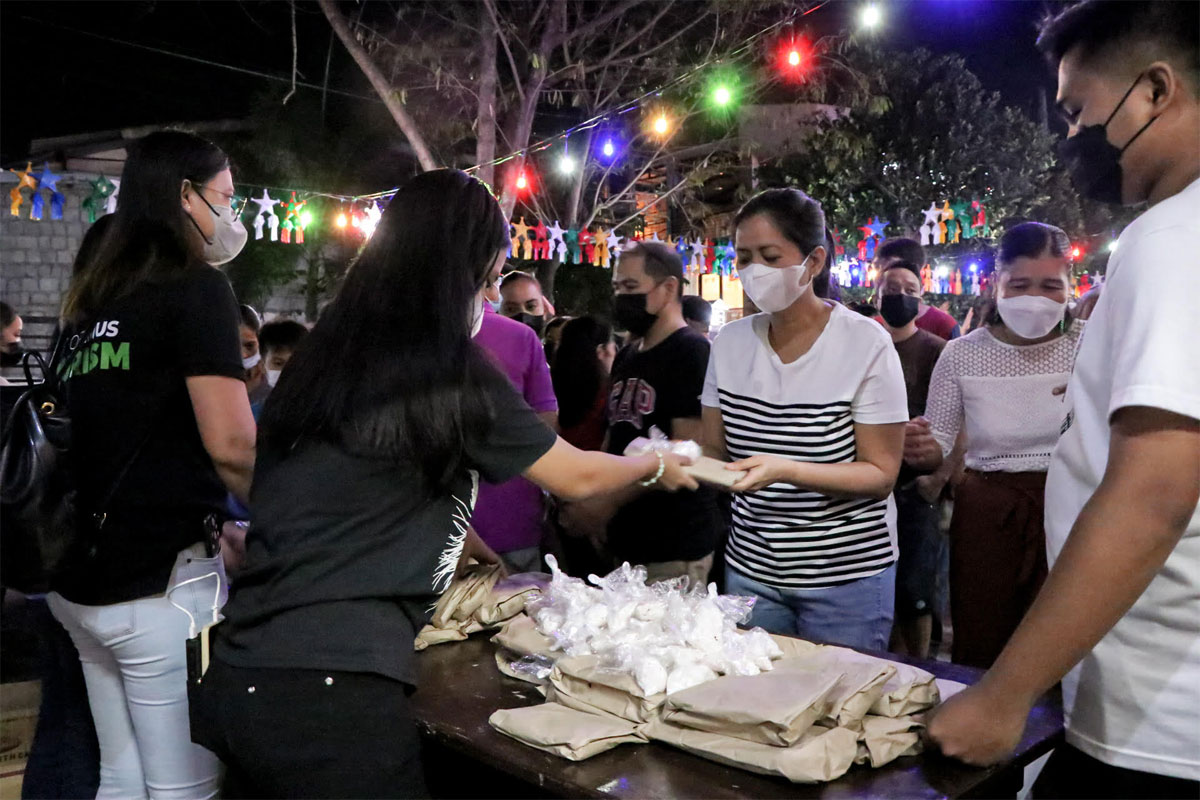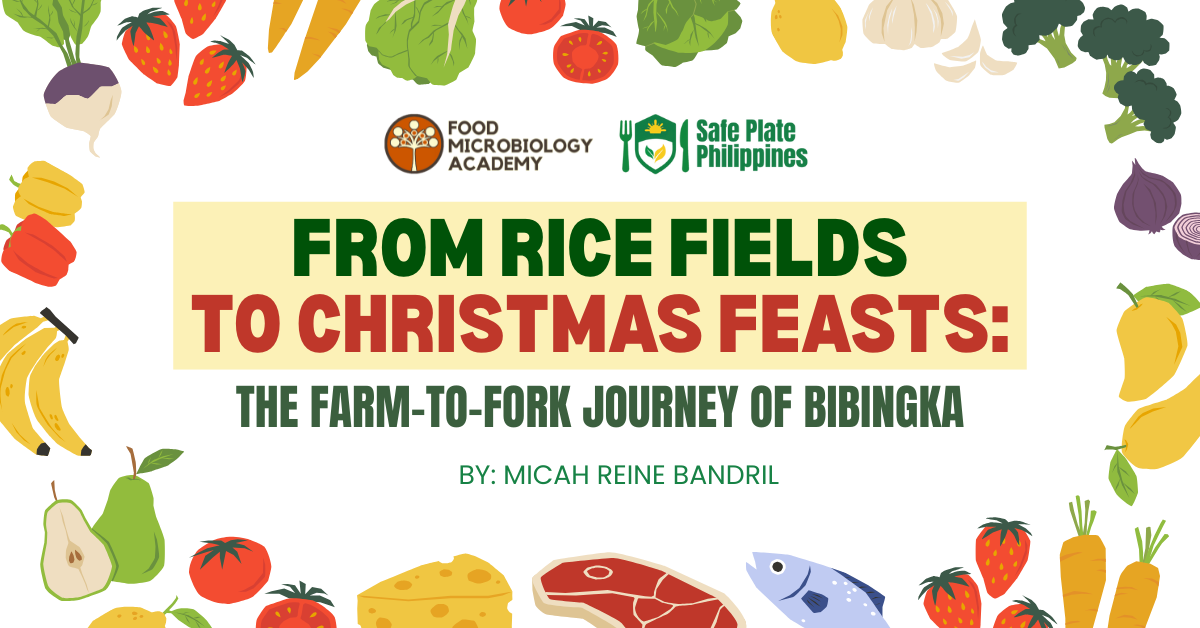This blog is written by Micah Reine Bandril under the theme “From Farm to Fork” and as part of the #SafePlatePH digital advocacy campaign promoting practical, science-based food safety for Filipino homes.

Photo from: Friend Cheap Menu
Can you think of a snack that oozes the warm smell of coconut milk mixed with the earthy scent of freshly ground rice, one that rises from clay pots lined with banana leaves?
You got it! It is bibingka, the beloved Filipino rice cake that fills the air outside churches during the early mornings and evenings of the Christmas season. As families arrive together for Simbang Gabi, this delicious treat has been something they look forward to as it has been a part of Filipino tradition for generations. Now I want you to think about where bibingka’s ingredients come from, and how it makes its way from the farm to your plate. What kind of processes does it undergo before you get your hand on it?
Bibingka is a type of rice cake native to the Philippines, traditionally made from galapong (ground soaked glutinous rice), coconut milk, margarine, and sugar (Merano, 2021). Made with sweet rice flour, rich coconut milk, and just the right amount of sugar, bibingka definitely showcases the distinct flavors that we, Filipinos, enjoy (Janelle, 2023). This cherished dessert is a prime example of the country’s rich agricultural heritage, culinary craftsmanship, and cultural identity of the Filipino people. Most especialy After Simbang Gabi services, stalls selling Filipino delicacies like bibingka create a warm atmosphere that brings the togetherness among families (Gabuya, 2023).
If you’re interested in tracing the farm-to-fork journey of bibingka, this blog post is for you! In the following paragraphs below, we will be examining how this beloved rice cake travels from the fertile fields of Filipino farmers to the warm hands of eager consumers gathered outside churches and in family kitchens.
Agricultural Origins: The Farm Stage

Photo from: Eco-Business
The journey of bibingka starts in the agricultural environment of the Philippines, where various crops help develop its flavor and texture.
Key Ingredients and Where They Come From
Rice serves as the foundation of bibingka, with specific kinds that are used for their distinct properties. Traditional bibingka is made from ground soaked glutinous rice (galapong), which provides its specific texture (Bebs, 2020; Janelle, 2023). Our country produced around 20.06 million metric tons of unmilled rice in 2023, which marks the highest production volume within the recorded period (Balita, 2025). However, production has encountered roadblocks, with rice production decreasing by 5.5% in the first half of 2024, dropping from 9.05 million MT in H1 2023 to 8.53 million MT in H1 2024 (PCAARRD’s ISP-IS, n.d.). Rice farmers along the country use different cultivation methods, from traditional transplanting in flooded paddies to more modern direct seeding techniques. The process involves careful land preparation, seedling cultivation, transplanting, water management, and harvesting, which usually takes 120-150 days from planting the seed to its actual harvest.
Coconut provides both the coconut milk that gives rise to bibingka’s creamy texture and the fresh grated coconut used as its topping. The country produced near 14.89 million metric tons of coconut in 2023, though this reflected a drop from the previous year (Balita, 2025). There are 340 million coconut palms covering 3.502 million hectares of agricultural land in the Philippines, producing more than 14 billion nuts per year and providing employment to 25 million Filipinos in the coconut sector (Moreno et al., 2020). Coconut palms, which bear nuts throughout the year once they mature, start bearing in 6-10 years and keep bearing for 60-80 years. The harvesting is done by skilled climbers who climb tall palms to get mature coconuts, which are then processed to get the meat and milk used in making bibingka.
Local chicken eggs pave the way for the texture and richness of bibingka. Raising poultry in the Philippines ranges from small backyards to commercial farms, but native chicken breeds are usually preferred for their great taste. Aside from that, there is also the use of the distinctive salted duck eggs (itlog na maalat) as a popular topping over bibingka.
Sugar, which is mainly from sugarcane, sweetens the rice cake. Government agricultural statistics show that sugarcane is still one of the Philippines’ top agricultural exports and top crops production items (PCAARRD’s ISP-IS, n.d.). Particularly, the growth of sugarcane in the Philippines involves planting cane stalks, where the growth is maintained for 12-18 months. After which it is harvested and processed in sugar mills to generate the granulated sugar used in the preparation of bibingka.
Lastly, bibingka would not be complete without banana leaves as they are used for lining bibingka molds and imparting a slight hint of herbal aroma. This comes from the typical banana plants that are widely seen in the Philippines. After the mature leaves are harvested, they are washed and prepared for cooking purposes. This then requires careful picking and preparation to render them safe to eat and flexible.
Seasonality and Sourcing
The seasonality of farm work highly affects the production of bibingka. Coconuts are perennial, but rice crops are seasonally harvested according to variety and location. During the peak Christmas bibingka season, demand for fresh produce spikes, which poses a problem for local supply chains. Consequently, modern bibingka manufacture increasingly depends on a mixture of native and imported alternatives, specifically rice flour and coconut products. This comes at the expense of traditional authenticity in order to make way for commercial convenience and guaranteed supply.
Processing and Transportation: From Farm to Market

Photo from: Philstar.com
The transformation of raw agricultural products into bibingka ingredients involves multiple processing stages that bridge the gap between farm and kitchen.
Post-harvest Processing
The conversion of raw farm produce into ingredients for bibingka constitutes a sequence of steps on the farm-to-kitchen link.
The production cycle starts with a meticulous preparation of each ingredient. Rice is milled to dehusk and debran, soaked and milled into galapong, the fine rice paste that serves as the foundation of bibingka. This process, which was once conducted with stone grinders, is now often performed with electric mills that are capable of producing uniform, fine-grained galapong required for truly quality bibingka.
Coconut processing is then followed by multiple steps: cracking, husking, and extracting the flesh from mature coconuts. The raw flesh of coconut is grated and pressed to yield rich coconut milk, with the first pressing yielding thick coconut cream and subsequent pressings yielding lighter coconut milk. Modern processing mills use mechanical graters and hydraulic presses; however, traditional processing using hand-grating and cloth-pressing is still common in rural settings.
Refining of sugar converts raw sugarcane juice into granulated sugar through a multi-step extraction, clarification, crystallization, and drying process. Eggs go through cleaning, grading, and in certain instances, preservation treatments, especially for the salted eggs used as bibingka toppings.
Transportation and Supply Chains
The journey of bibingka ingredients from rural production points to urban consumption areas also involves a wide network of logistics. Perishable ingredients like coconut milk and galapong have limited shelf life and, therefore, effective cold supply chain maintenance is needed to maintain quality and safety. Wet markets as the traditional primary distribution areas provide retailers of fresh galapong, coconut milk, and other ingredients on a day-to-day basis.
Contemporary supermarkets continuously stock packaged versions of traditional bibingka ingredients, such as the pre-made rice flour, canned coconut, and frozen galapong, making it easier but occasionally compromising traditional taste and texture. However, there could still be transport issues including spoilage during transport, particularly in hot climates, cost considerations in determining the price of ingredients, and weather-related disruptions impacting availability during the peak season for bibingka.
As it is a favorite snack during Christmas time, the supply chain’s efficiency is necessary as there is a flood of bibingka orders. Hence, the coordination between farmers, processors, distributors, and sellers must be tight to ensure enough ingredients.
Preparation Stage: From Market to Kitchen

Photo from: Dreamstime.com
The process of transforming raw materials into bibingka is the combination of farm work and kitchen craft, wherein traditional processes mix with modern adjustments.
Purchasing and Preparation
Good bibingka making starts with proper selection of its ingredients. Skilled cooks select fresh banana leaves that are firm, bright green, and unbroken with no brown spots on them. Then, fresh coconuts are picked by weight and the sound when liquid inside rings out when the coconut is shaken. Additionally, rice is picked by the quality of its appearance, smell, and texture.
Aside from those, banana leaves also need careful preparation: they are rinsed thoroughly, briefly heated to make them more flexible, and subsequently sliced to proper size for use in lining molds. As mentioned above, the careful preparation done for it not only guarantees food safety, but also lets out the leaves’ delicate herbal smell while cooking, which in turn contributes to the distinctive smell of bibingka.
Bibingka Batter Creation
The secret to bibingka preparation lies in achieving the ideal batter. Soaking glutinous rice in advance overnight or a few hours and pounding it with water to produce silky galapong are the traditional ways. Rice flour and glutinous rice flour form the signature soft, lightly chewy texture characteristic of bibingka, while the coconut milk has richness and a hint of tropical flavor that pure milk cannot match (Kusina Secrets, 2024).
Modern recipes usually call for commercial rice flour mixed with water or coconut milk, but traditional cooks insist that this produces a texture that is below par compared to freshly made galapong. To even further improve the batter, eggs are added for texture, sugar for sweetness, and coconut cream for additional richness in some recipes. Then, salt balances the sweetness, and baking powder can be added for additional lightness in modern recipes.
Cooking Process
The traditional method of cooking bibingka is through the use of special clay pots (palayok) with coals both underneath and on top of the pot, evenly distributing heat that creates the signature top and bottom golden-brown crusts. Banana leaf-lined pots are filled with batter and covered with clay lids with burnt coals on top, creating a mini-oven-like situation that cooks the bibingka to perfection.
Modern cooking techniques use ovens, electric bibingka cookers, or pans that simulate the old method of cooking. While these approaches may be convenient, they cannot exactly mimic the characteristic smoky flavor and texture achieved by cooking over clay pots.
To ensure your delicious delicacy, the preparation calls for precise heat and timing control. Bibingka that is well cooked is golden brown on the outside and still moist and slightly sticky on the inside. Coconut, rice, and light smokiness fragrances in the cooking process are indicators of near doneness.
Toppings and Presentation
The bibingka toppings elevate the plain rice cake to a wonderful eating experience. Thin pieces of salted eggs contribute a rich saltiness that is enhanced by the sweet base, and shredded fresh coconut contributes texture and tropical flavor to the cake. It is also an option to add melted butter to the cake, which even more flavor. Furthermore, white cheese (kesong puti) can also be a topping to add creaminess and saltiness to balance the overall sweetness.
Lastly, presentation is, of course, an equally important part of the whole process. Warm bibingka is wrapped in banana leaves to retain the heat that we love while eating this treat. As a result, the presentation of this golden cake dotted with orange egg yolk circles and white cheese and sprinkled with coconut shreds allows for it to be as much a feast for the eyes as for the taste buds.
When Food Becomes a Community

Photo from: Journalnews
The farm-to-fork journey of bibingka is, in a very real way, a snapshot of how a community sustains itself. It starts with the farmers whose work transforms sunlight, soil, and water into the rice and coconuts that provide the basis for this delicacy. It then continues through the millers, coconut processors, and food vendors that all contribute their skill, labor, and care. As it concludes at the dining table, families and friends come together to enjoy a dish whose meaning is felt as deeply as it is savored.
From this understanding, bibingka is both a seasonal dish and a good example of the interconnectedness of agriculture, trade, and culture. Its sustainability depends on the integrity of each connection in the chain, even in the face of climate change, shifting economies, and shifting consumer tastes. So the sustainability of bibingka is actually preserving this whole web of connections.
When we enjoy bibingka during the Christmas season, we’re also taking part in a chain of work, care, and tradition that began long before the batter hit the clay pot. Every bite carries the effort of farmers who tended the rice and coconuts, the skill of those who milled, mixed, and baked, and the spirit of communities that have kept this tradition alive for generations now. By being aware of how it is actually made from farm to fork, we realize how this precious rice cake is also a subtle reminder that culture is sustained when people choose to keep showing up for it season after season, and year after year. So, what’s your bibingka story?
References
Balita, C. (2025, August 7). Agriculture industry in the Philippines. Www.statista.com. https://www.statista.com/topics/5744/agriculture-industry-in-the-philippines/
Bebs. (2020, December 23). Bibingka Recipe . Foxy Folksy. https://www.foxyfolksy.com/bibingka-recipe/
Gabuya, K. M. (2023, December). Sacred Moments: Experiencing Simbang Gabi in Filipino Culture. Cebu Daily News; INQUIRER.net. https://cebudailynews.inquirer.net/543156/sacred-moments-experiencing-simbang-gabi-in-filipino-culture
Janelle, A. (2023, December 7). Bibingka: The Journey Through Generations and Traditions. Medium. https://medium.com/@janelleamiyah/bibingka-the-journey-through-generations-and-tradtions-8bd832482f5b
Kusina Secrets. (2024, October 31). Bibingka Recipe (Traditional Filipino Christmas Rice Cake) – Kusina Secrets. https://kusinasecrets.com/bibingka/
Merano, V. (2021, December 22). Bibingka Recipe. Panlasang Pinoy. https://panlasangpinoy.com/rice-cake-bibingka-recipe/
Moreno, M. L., Kuwornu, J. K. M., & Szabo, S. (2020). Overview and Constraints of the Coconut Supply Chain in the Philippines. International Journal of Fruit Science, 20(SUP2), 1–18. https://doi.org/10.1080/15538362.2020.1746727
PCAARRD’s ISP-IS. (n.d.). Rice – Industry Strategic Science and Technology Program. https://ispweb.pcaarrd.dost.gov.ph/isp-commodities/rice/



